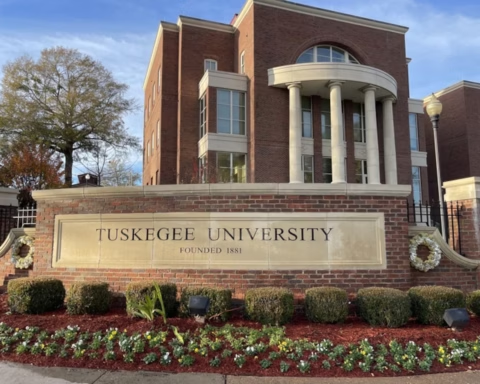Courtesy of Tuskegee University
The research conducted at Tuskegee Infantile Paralysis Center at Tuskegee Institute to eradicate polio decades ago was acknowledged Aug. 4 with the unveiling of a monument provided by fundraising and collaboration of the Rotary Club.
The life-size bronze statue depicts Dr. John W. Chenault, nurse Warrena A. Turpin and a young polio patient named Gordon Stewart. They represent the spirit of excellence that was prevalent at the Tuskegee Infantile Paralysis Center, where Black doctors, researchers and support personnel conducted significant work critical to eradicating polio.
The monument’s permanent home is in front of the Museum beside John A. Kenney Hall in what once was the John A. Andrew Memorial Hospital where the Infantile Paralysis Center treated many young Black polio patients.
In 1985, Rotary International and its partners committed to removing the disease from the face of the earth. The statute was commissioned by the Rotary District 6880, which is a consortium of Alabama Rotary Clubs, with support from the Tuskegee University Archives staff through the Tuskegee Polio Recognition Project.
“I’d like to acknowledge the partnership with Rotary District 6880 and its members for their work with the Tuskegee Polio Recognition Project to erect this monument,” said Tuskegee President Dr. Charlotte P. Morris. “We are grateful for their acknowledgment of the dedication of Black researchers and doctors to fight the war against polio.”
Special guests of the Aug. 4 activities included family members of former doctors and researchers, Rotary members, leaders of the March of Dimes, Alabama representatives, and guest speaker Federal Judge Myron H. Thompson. A native of Tuskegee, Judge Thompson was diagnosed with polio at 2 and was bedridden, then confined to a wheelchair before working to recover and walk with just a limp.
Black doctors and researchers at the Tuskegee Infantile Paralysis Center were dedicated to treating and removing polio from the African American community. In the early years of the fight against polio, the Tuskegee Paralysis Center was the only place in the South where African American children with polio could come for treatment.
Tuskegee’s former Board Chair Basil O’Connor, for whom the major nursing building is named, was instrumental in creating the National Foundation for Infantile Paralysis, which later became the March of Dimes. He knew in a segregated America, where Black contributions to science and medicine were heavily discounted, what Tuskegee researchers were doing and supported their work for the good of our community and the nation.





